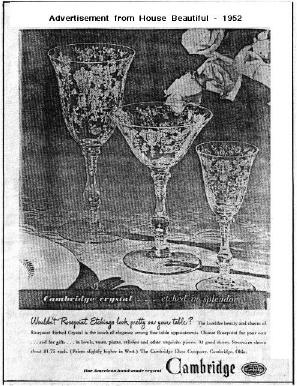National Depression Glass Association
Preserving America's Glass Manufacturing Heritage
Cambridge Rose Point
by Virginia Scott
Rainbow Review Glass Journal - May 1974
In the 1942 survey, "The 15 Most Popular Glassware Patterns" (refer to April 1974 Rainbow Review article), Cambridge Glass Company named their "Rosepoint Etched Crystal" (or "Rose Point") as their most popular pattern. A 1954 ad described Rosepoint as "Lacework on crystal, magnificent beyond compare! The lace-like traceries, richly aglow, are etched on classic forms of timeless beauty."
 Cambridge
Glass Company was founded in 1901 in Cambridge, Ohio, and produced fine
handmade glass of many styles for 53 years. Cambridge glass was known
and sought after all over the world. Imperial Glass Corporation
purchased the Cambridge molds, trademarks and patents in 1960 and has
reproduced some items. Cambridge glass is one of the leading
collectibles today.
Cambridge
Glass Company was founded in 1901 in Cambridge, Ohio, and produced fine
handmade glass of many styles for 53 years. Cambridge glass was known
and sought after all over the world. Imperial Glass Corporation
purchased the Cambridge molds, trademarks and patents in 1960 and has
reproduced some items. Cambridge glass is one of the leading
collectibles today.
I have found many Cambridge advertisements in the popular magazines such as House & Garden, House Beautiful, American Home and Better Homes and Gardens. The earliest ads (1937) were small, 1/8 page ads; later, the sizes were increased and during the late 1940s and early 1950s, many were full-page ads and some were even in color. Many patterns were advertised, but ads for the "Cambridge Etchings" - Rosepoint, Chantilly, Wildflower, Candledlight, Diane, Elaine, Portia - appeared most frequently.
The Cambridge Etchings ads are quite interesting to read. Cambridge stated that their etching process was "unique" and many ads spoke of their "highlighted" etchings. A 1940 ad invites readers to "Make this test. Merely place a Cambridge etching beside any other etching. You will see, instantly, why experts rank Cambridge craftsmanship as America's finest." The ad explained "In the art of etching beautiful and intricate patterns on glass - a difficult art, involving problems different from the etching of any other material - Cambridge stands supreme. Utterly unlike ordinary frosted etchings, each delicate tracery is alive with light, glowing from myriad tiny crystal surfaces, with an incomparable richness." Other ads claimed that Cambridge glass was "noted for its permanent brilliance and clarity" and its "clear purity" and that it had "quality supreme." Some ads maintained that Cambridge had "The most complete selection of exclusive, patented shapes and designs in America" and offered "an exceptionally wide range of pieces" which were "modestly priced at stores where nice things are sold."
When my husband and I were married in 1941, we received many pieces of Cambridge Rosepoint as wedding gifts. Today, as I prepared this article, I took a Rosepoint goblet from my china cabinet and examined it closely. The overall pattern of roses and medallions is truly "exquisite lacework on crystal," the "flawless crystal" catches the light and glows with "luminous beauty," the 4 inch stem is, indeed, a "classic form of timeless beauty." In my hand, I held "the highest expression of glassware loveliness" - "magnificence beyond compare" - "Cambridge Crystal - etched in splendor." Those of us who possess Rosepoint are fortunate indeed. We possess "crystal to cherish through the years" - "beauty to treasure."
[Note: All quotations are from Cambridge Advertisements.]